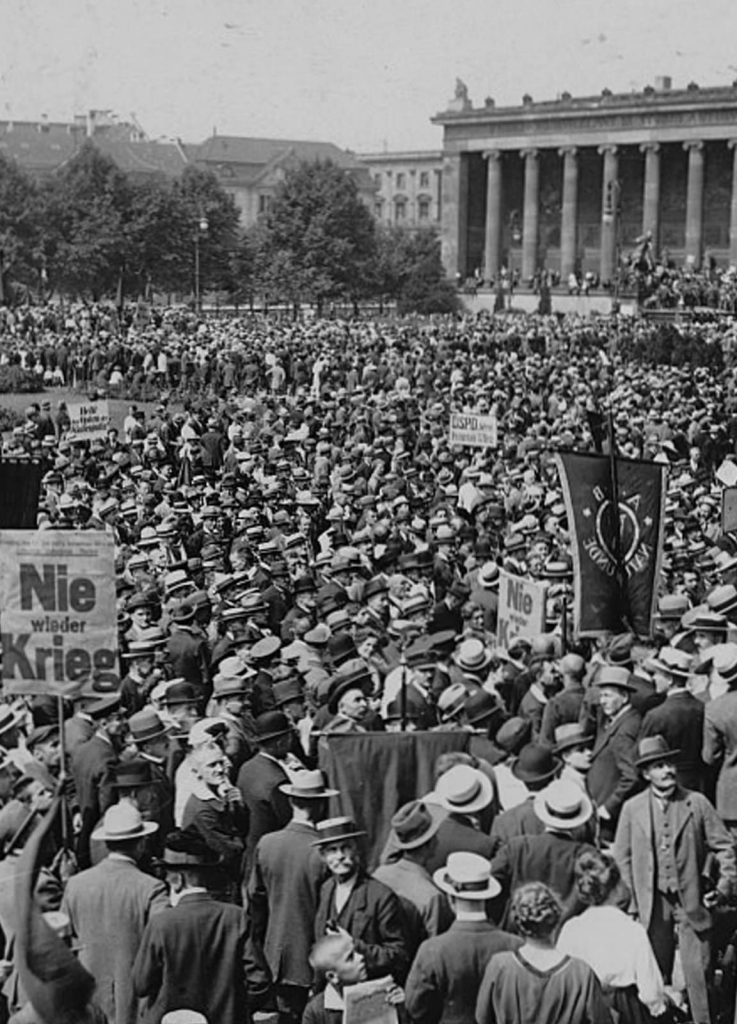The present issue deals with some of the peace and anti-militarist movements linked, chronologically or thematically, to World War I, marking the culmination of the commemoration of its centennial. We specifically take a look at the more political movements, such as those linked to anarchism (First International) or to the main leader of the Spartacus League, Rosa Luxemburg, the anti-draft groups and the pioneering work in the academic world of Albert Fried, one of the creators of the epistemic community that is behind the most radical perspectives of international relations and peace research. In addition, Joan Botam, a priest and ecumenist, reflects on the legacy of the Great War and opposition to it among the various peace movements inspired by religious beliefs.
In other issues we have dealt with the role of women and feminist movements. And we are well aware of the fact that we did not exhaust the richness of those movements. We are also aware that important changes took place between World War I and World War II, such as the critical impact with the movements most closely linked to the leaderships of the Second International or the arrival of crucial influences such as the Fellowship of Reconciliation, the War Resisters League and, especially, Gandhi’s radical pacifism. Without them, the origin of peace research, which emerged in the 1950s on both sides of the North Atlantic, and thus our own work, cannot be understood.
There is an idée-force that follows from these articles: social movements (in this case, pacifist and anti-militarist) are at the root of the academic, civic and political struggles for peace as well as those waged by international organizations. Without them, nothing would be possible: they have been an essential factor and a key actor from the moment when, for the first time in modern history, the clamor of “never again” (meaning never again a war like this one) broke out. They had already proved to be essential after the battle of Solferino, which revealed the terrible consequences of increasingly sophisticated weapons such as the “needle gun,” the first quick-firing, semi-automatic rifle, and they were therefore crucial in the creation of the International Red Cross and in the development of humanitarian law and the law of war.
Social movements are at the root of the struggles for peace and without them nothing would be possible
And they proved to be essential, even more decisively, before, during and after World War I, when, for the first time, the social outcry, generated in part by these movements, demanded an intellectual response to the problem of war. As is often said, it was precisely after the war when the social concern about war became an intellectual concern. This gave rise to the creation of International Relations as a discipline, to understand the causes of war and to establish the conditions of peace, in the pursuit of a lasting and sustainable peace. Without peace and anti-militarist movements, and without their impact on public opinion, nothing that has happened in the analytical, political and social field for peace in the last one hundred years would have any explanation or make any sense.
That is why we must go beyond the duty of remembering and honoring those pioneers. At a time when the impact of social peace movements has again become crucial, and when we salute the agreement between Iran and the nuclear powers, (which, if it goes into effect, will have a decisive impact), it is important to remember some of the lessons of the past. Four, to be precise.
Without peace and anti-militarist movements, nothing that has happened in the analytical, political and social field for peace in the last one hundred years would make any sense
First, that peace is a process, not a specific state that is reached to remain there, and, as a process, it demands dynamism to adapt to the context and consequences of other intermediate values such as dignity and justice. In other words, peace is built. Second, peace is expressed in many ways; in fact, there are many forms of peace and therefore it is essential to keep in mind, in the intellectual agenda and in the agenda of struggle, that there are different agendas, different biases and perspectives and different accents and sensibilities, all of which are essential. In intellectual, social and civic endeavors, the peace agenda requires the capacity to include different voices, all of which are crucial, with special attention paid to those that come from the global South, from other cultures. Third, that the threats to peace constantly mutate, as demonstrated by the fact that the deaths caused directly by war or terrorism represent less than 25% of all deaths worldwide and that therefore the agenda and instruments of analysis and intervention must always be fine-tuned, improving progressively to grasp what is new and propose forms of collective action to solve problems generated by novelty.
And fourth, that the achievement of peace requires a combination of social and civic action, academic action and endeavor, and also political advocacy and work in the institutions. Working on minds, hearts and institutions, and not just in a formal sense. As our former vice-president and friend Alfons Banda used to say, it requires conquering public opinions, that is to say, creating narratives and counter-narratives that demonstrate that peace has never been a chimera, an impossible, but a utopia that is built, a utopia with a long history and many partial successes. There are always “First World Wars” to fight against or, in the words of Alfred Fried, “demonstration objects with which to teach anatomy.” So thank you, peace, pacifist and anti-militarist movements, for your great contribution to “anatomy.”
Photography : United States Library of Congress
– No More War demonstration, Berlin 1922 –
© Generalitat de Catalunya
